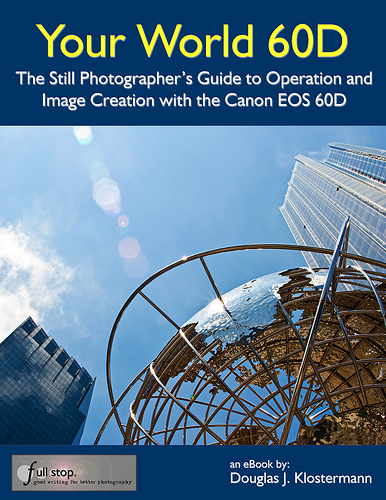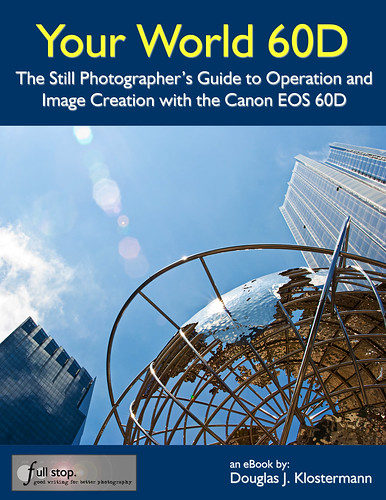Looking for a Canon EOS 60D book or tutorial to help you learn and begin to master your new dSLR? I’ve written an eBook user’s guide for the Canon 60D, called Your World 60D – The Still Photographer’s Guide to Operation and Image Creation. Learn to use the Canon 60D quickly and competently, and improve your photography and capture better images. The 60D is an advanced tool, and this guide explains how to start to use it to its full potential. Begin to take control of your camera, the image taking process, and the photos you create.
This instant download eBook guide is for those who wish to get more out of their 60D, and go beyond Auto or Program mode and shoot in Aperture Priority (Av) mode and Shutter Priority (Tv) mode. It covers basic dSLR camera functions and exposure concepts for those new to digital SLR photography, plus it also explains more advanced camera controls and operation, such as using the various metering modes and exposure compensation for correct exposure of every image, controlling autofocus modes and focus points for sharp focus of still or moving subjects, and creating dramatic depth of field for professional looking photographs. Learning to get the most out of a dSLR can involve a steep learning curve, and I believe my book can help you speed up that process.
See below for how to purchase. You can preview Your World 60D at the following link. The preview shows the Table of Contents, Introduction, a sample Menu Settings page, a sample Custom Functions Settings page, and a sample text page.
Preview: http://www.dojoklo.com/writing/Your_World_60D-Preview.pdf
Your World 60D is a text-only PDF guide that builds upon the information offered by the camera’s manual and focuses on the essential functions and settings for real world 60D use. In addition to covering the various settings, functions and controls of the Canon 60D, its lessons explain when and why to use them. It also describes every Menu setting and Custom Function setting, with recommended settings, including Movie Mode menus. Note that it focuses on still photography and not video except for a brief introduction to menus and important video settings to get you started.
Sections include:
- Setting Up Your 60D – All of the Menu settings and Custom Function (C.Fn) settings, including movie mode menus, with brief descriptions and recommended settings for practical, everyday use. Set up and customize the advanced features of the 60D to work best for the way you photograph.
- Aperture Priority Mode (Av) and Shutter Priority Mode (Tv) – How and when to use them to create dramatic depth of field or to freeze or express motion.
- Auto Focusing Modes and Drive Modes – How they differ, how and when to use them to capture sharp images of both still and moving subjects. Also how and when to use focus lock and back-button focusing.
- Exposure Metering Modes – How they differ, how and when to use them for correct exposures in every situation. Also how to make use of exposure lock.
- Histograms, Exposure Compensation, Bracketing, and White Balance – Understanding and using these features for adjusting to the proper exposure in challenging lighting situations.
- Composition – Brief tips, techniques, and explanations, including the creative use of depth of field.
- The Image Taking Process – A descriptive tutorial for using the settings and controls you just learned to take photos.
- Photography Accessories – The most useful accessories for day-to-day and travel photography
- Introduction to Video Settings – Some basic settings to get you started
This digital field guide to the Canon EOS 60D is a 40 page, PDF format text-only document, full of helpful information applicable to the new and intermediate dSLR photographer – to turn you into an advanced digital photographer! Begin to master your Canon 60D and start to use it to its full capabilities.
Purchase Your World 60D through PayPal here! (or click the PayPal or Credit card check-out button below)
This version is in PDF format, text-only, 8.5″x11″, which can be read on your computer screen, printed on your printer, taken with you on your laptop, and can also be read on the iPad.
Format: PDF – Instant Download
Page Count: 45
Price: $9.99
(plus 6.25% sales tax for residents of Massachusetts)
Secure payment with PayPal or Credit card
Other versions of Your World 60D e-book:
The Kindle edition is available on Amazon.com
The Nook edition is available online at Barnes and Noble
The iPad and iPhone version is available through Apple’s iTunes or through the iBooks App.
What Readers are Saying about Doug Klostermann’s dSLR User’s Guides:
This book, together with the manual that came with your camera, is all you need to start discovering all the potential of this camera.
-Max M.
It’s the first guide I’ve read which has taken me through all the settings in an understandable way. I now feel that I have control over the camera.
-Peter S.
I would recommend this to anyone who wants to get a quick start to using their camera. Manuals are nice, but this eBook highlights the important information and gives a quick easy to understand explanation of most all of the functions and controls.
-Ray M.
I found the (camera’s) manual good for understanding how to set things up but not much on the why – this book really focuses on the “why.” Prior to reading the book I was setting up my metering on Spot Metering thinking it was much better than Matrix (Evaluative) – the guide helped me understand why to use specific settings for specific needs. The Custom Settings sections helps to make firm decisions on how to apply settings by understanding the usage of each in addition to knowing how to set them up. I would like to thank you for saving me time – now I’m confident that my camera is well tuned!
-Benoit A.
This manual is a clearly written, concise and useful explanation of the rationale for the seemingly infinite and often confusing settings options. Used in conjunction with the (camera’s) manual I feel a bit more confident in understanding how to at last proceed in getting better photographs.
–WLS
Your World 60D was originally, briefly titled Real World 60D. It is the same eBook. If you use the Canon Rebel T2i/EOS 550D, or Canon Rebel T3i/EOS 600D have a look at my eBooks for those camera, T2i Experience and Canon T3i Experience.




